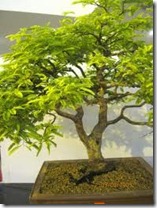 Few subjects in bonsai care are as complex as watering. What should be the simplest thing in the world is actually the most complicated. Apprentices in Japan will perform many duties for their first few years before being allowed to water the trees. Incorrect watering practices kill more bonsai than any other factor.
Few subjects in bonsai care are as complex as watering. What should be the simplest thing in the world is actually the most complicated. Apprentices in Japan will perform many duties for their first few years before being allowed to water the trees. Incorrect watering practices kill more bonsai than any other factor.
Bonsai soil is quite different from standard potting earth. By design, it is porous and provides very rapid drainage. As a result, frequent and copious watering is needed. But over-watering is just as dangerous, if not more so, to the health of the bonsai. Over-watering can lead to the growth of harmful fungi and to root rot.
Both of these damaging extremes can be avoided, though. By following these tips a complex art can be turned into, if not a simple routine, at least a healthy practice.
Knowing how much water is needed is the first step. It’s important to develop a method for testing the soil moisture content.
As a quick check, touch the surface with your thumb. If it feels dry, it is. Gently scrape back any ground cover, gravel or surface earth to perform a better check.
A more accurate test can be accomplished easily by using a standard moisture gauge. Often looking like an ordinary thermometer, analog or digital displays will provide an accurate reading.
They only tell part of the story, however, since they detect water only near the tip. Dry spots can occur within the pot that are harmful, if they’re near the roots. As roots spread throughout the pot over time, that can be many places.
To ensure that the entire soil is adequately moistened, once a month dip the pot up to the base of the tree into a bucket or sink filled with water. Let the pot absorb water for a few minutes, then carefully remove by lifting by the pot, never by the tree.
If the soil is correct, and the plant is not root bound, excess moisture will drain out the bottom through the mesh-covered hole and into the tray under or attached to the pot. If the tray is full, dip the pot slightly to allow only a low level of moisture to remain.
Draining excess water from the tray will ensure that any excess water in the pot has somewhere to go, and doesn’t collect around the roots.
Water daily, making sure that water flows to the bottom but doesn’t pool to the point of filling up the tray. Water left standing in the tray not only makes it impossible for the pot to drain, but encourages mold build-up.
Whether more than daily watering is required depends on the type of soil in the pot and your climate. But, the amount of water needed also varies from species to species.
Pines and other conifers need less water. They benefit from moderate drying periods, as well. Deciduous and flowering trees require and welcome more water than conifers. Look for curled leaves on deciduous trees, indicating dryness. Check that flowers aren’t wilting when they should be blooming.
A certain amount of experimentation, accompanied by a careful measuring regime, will be necessary to adjust to your specific tree and circumstances.

Deprecated: strpos(): Passing null to parameter #1 ($haystack) of type string is deprecated in /home/agriviek8Qv/agriviet.net/public_html/wp-includes/comment-template.php on line 2522